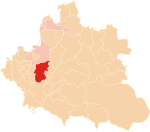Battle of Warsaw (1831)

The Battle of Warsaw was fought in September 1831 between Imperial Russia and Poland. After a two-day assault on the city's western fortifications, the Polish defences collapsed and the city was evacuated. It was the largest battle and the final episode of the Polish–Russian War of 1830–31, a conflict that became better known as the November Uprising. After almost a year of heavy fighting, a large Russian force crossed the Vistula and besieged the capital of Poland on 20 August. Although the siege was partially lifted soon afterwards and a successful sortie allowed a communication route between the city and the rest of Poland, a large Russian force remained on the left bank of the Vistula and continued to threaten the city. Russian commander Ivan Paskevich counted on Polish surrender as his Polish counterpart, Jan Krukowiecki, was known to be a member of the moderate political forces, willing to negotiate with Russian tsar Nicholas I, who had been deposed from the Polish throne in January 1831 by the Sejm (Polish parliament). When a less conciliatory faction gained power in Warsaw and the Russian offer of surrender was refused, Paskevich ordered his forces to launch an assault against Warsaw's western defences. The assault started on 6 September 1831. Russian forces surprised the Poles by attacking the strongest Polish position in the suburb of Wola. Despite staunch defence of some of the ramparts, especially Fort 54 and Fort 56, after the first day the outer line of Polish defences had been breached by Russian infantry and artillery. The following day fights resumed, but this time Russian artillery was close enough to shell the western boroughs of the city itself. Although losses were similar on both sides, Polish authorities decided not to risk another Massacre of Praga and ordered the evacuation of the city. On 8 September 1831 Warsaw lay in Russian hands, and the remainder of the Polish Army retreated to Modlin. The November Uprising ended soon afterwards, with the remnants of the Polish Army crossing the borders of Prussia and Austria, to avoid being captured by the Russians. In the 19th century the fight for Warsaw became one of the icons of Polish culture, described by, among others, Polish romantic poets Adam Mickiewicz and Juliusz Słowacki. It was also the main inspiration behind Chopin's Revolutionary Étude, initially called the Étude on the Bombardment of Warsaw. The fall of Warsaw also garnered sympathy for the Poles and their quest for independence.
Excerpt from the Wikipedia article Battle of Warsaw (1831) (License: CC BY-SA 3.0, Authors, Images).Battle of Warsaw (1831)
Wojciecha Górskiego, Warsaw Śródmieście (Warsaw)
Geographical coordinates (GPS) Address Nearby Places Show on map
Geographical coordinates (GPS)
| Latitude | Longitude |
|---|---|
| N 52.233333 ° | E 21.016667 ° |
Address
Wojciecha Górskiego 3
00-033 Warsaw, Śródmieście (Warsaw)
Masovian Voivodeship, Poland
Open on Google Maps











